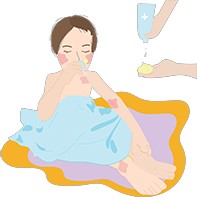Helping your child with atopic dermatitis
This handout provides some information about treatments for children with atopic dermatitis
What your child should avoid
- Soap, bubble bath and shampoo
- Woollen, nylon or furry clothes and items, including wool blankets, toys, bunny rugs, car seat covers, clothes you are wearing when carrying your child
- Sandpits and sand at the beach
- Chlorinated water
- Perfumed products
- Overheating – for example, wearing tight nylon clothes, using electric blankets, participating in activities like aerobics or athletics
- Known, proven allergens
How you and your child can do this
- Use a soap substitute instead of soap and shampoo, and use a bath oil in the bath
- Keep products used on the skin simple and nonperfumed; experimentation can result in irritation of the skin
- Wear loose cotton or cotton-blend clothes
- Do not put more clothes on your child than you would wear yourself, and avoid sudden temperature changes
- Remove the sandpit at home, speak to the teacher at preschool about avoiding sand, and immediately wipe off any sand that gets on your child
- Rinse off chlorinated water immediately and apply moisturiser
- If your child has a proven dust allergy use a dust cover for your child’s mattress and pillow; remove fluffy toys from the bedroom, hot wash bedding and clothes and vacuum regularly
What you should do each day
- Apply a bland, greasy moisturiser all over your child twice a day: after the bath and before getting dressed in the morning are the best times
- Always use bath oil in the child’s bath
- Check daily to see which parts of the skin have dermatitis: use your child’s cortisone creams and ointments on these areas at the strength recommended by your doctor
Using cortisone creams
Many people will tell you that cortisone creams and ointments, which are usually preferable to other products, are very dangerous and should not be used on children.
It is true that cortisone (also called corticosteroid) is a potent and effective medication; however, it is completely untrue that it is too dangerous to use in atopic dermatitis.
The truth is that cortisone creams are very safe when used correctly. Inadequate use of these creams is one of the main reasons that parents find it difficult to control their children’s dermatitis.
You should use your cortisone creams on your child as soon as you see a patch of dermatitis. Waiting until the dermatitis gets really bad before using them only results in having to use more. The earlier you start, the better you will control the situation. When the dermatitis is better, stop using the creams.
What about Elidel?
Elidel (which is also called pimecrolimus) is a nonsteroid product for the treatment of dermatitis. It is called an ‘immunosuppressive’ drug, which means that it dampens down the body’s immune, or defence, system. Its strength is equivalent to a weak-to-moderate strength cortisone cream.
Elidel does not thin the skin. Its main side effect is stinging or burning. We have no information about the very long-term safety of this product. Until we know more, it is wise to use a sunscreen on any exposed areas being treated, as there are concerns about a possible link with skin cancer.
Elidel is not a highly effective treatment for dermatitis and is less effective than all topical corticosteroids other than 1% hydrocortisone. It is in general most useful on the face and eyelids.
Specific instructions
-----------------------------------------------------------------------------------
-----------------------------------------------------------------------------------
-----------------------------------------------------------------------------------
-----------------------------------------------------------------------------------
-----------------------------------------------------------------------------------
Problems your child might encounter
- Stinging. Particularly when dermatitis is severe, creams may sting. Sorbolene cream often causes stinging. If this happens, talk to your doctor about changing to another product.
- Night waking. This usually stops when the dermatitis is better, as it is the result of itching. Some sedating antihistamines, such as alimemazine (trimeprazine) tartrate, taken at bedtime will often help.
- Infection. If dermatitis becomes crusty or weeping or exudes pus, get in touch with your doctor. Your child may need antibiotics.
- No improvement. Sometimes dermatitis just becomes difficult to treat and does not respond to the usual medicines. Contact your doctor in this case. MT


